Acid Base Titration Theory
In chemistry, titration is a process by which a chemist can find the concentration of a solution with good accuracy, if she knows what substance is in it. This can be very handy for determining the concentrations of acids and bases, such as hydrochloric acid and sodium hydroxide. Typically, the chemist adds a second solution, drop by drop, until the mixture suddenly changes color, signaling the end of the titration.
Basic Process
Basic Process
The solution of unknown concentration is called the "titer." The added solution is called the "titrant." In acid-base titration, enough titrant is added to the titer to neutralize it. So if the titer is a base, a chemist adds an acid as the titer.
A lab technician adds a color indicator to the titer before it indicates the neutralization point. This is important because if he adds the titrant too fast, the technician can go right by the neutralization point and not know exactly how much titrant was needed to reach it.
Indicators
Indicators
In acid-base titration, the neutralization point occurs at a pH of 7.0. Litmus is a good indicator for an acid-base titration, because it changes color at a pH of around 6.5—close enough, as will be explained below. Since indicators react with the solution being measured, they should be used in moderation—only a few drops if possible.
Equivalence Point
Equivalence Point
The point at which the titrant fully neutralizes all the titer, leaving neutral water, is called the "equivalence point." This is when the titrant has "used up" all of the titer. The acid and base have fully canceled each other out. An example of this sort of mutual cancellation is illustrated in this chemical formula:
HCl+NaOH–>NaCL+H2O
At equilibrium, the solution's pH is 7.0.
Titration Curve
Titration Curve
If you use a pH meter, you can record pH on a regular basis as titrant is added. A plot of the pH (as the vertical axis) against the volume of titrant would produce a sloping curve that is particularly steep around the equivalence point. PH is a measure of the H3O+ concentration in a solution. Adding one or two drops to a neutral solution greatly changes the H3O+ concentration, by a factor of 10 or more. Doubling the amount added doesn't change the concentration nearly as much. This is what makes the titration curve so steep in that one region, and therefore makes the equivalence point so easy to identify in the graph. The amount of titrant needed to neutralize the titer is therefore easy to accurately quantify.
Potentiometric Titration
Potentiometric Titration
A titration curve can also graph conductivity (as the vertical axis) against titrant. Acids and bases conduct electricity. Therefore, you can measure conductivity by inserting electrodes into the titer. The electrodes would be attached to a battery and ammeter (or voltmeter). The titration curve will change precipitously at the equivalence point. In this case, conductivity will have a noticeable minimum at the equivalence point. This method has the benefit of not needing an indicator, which could interfere or participate in the neutralization reaction, affecting its results.
Cite This Article
MLA
Dohrman, Paul. "Acid Base Titration Theory" sciencing.com, https://www.sciencing.com/acid-base-titration-theory-5534715/. 29 April 2018.
APA
Dohrman, Paul. (2018, April 29). Acid Base Titration Theory. sciencing.com. Retrieved from https://www.sciencing.com/acid-base-titration-theory-5534715/
Chicago
Dohrman, Paul. Acid Base Titration Theory last modified August 30, 2022. https://www.sciencing.com/acid-base-titration-theory-5534715/
